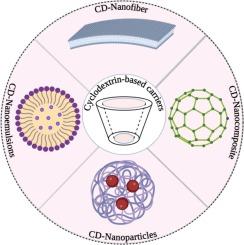Cyclodextrin nanocarriers in Coordination Chemistry: Enhancing encapsulation and targeted delivery of 5-Fluorouracil for cancer treatment
IF 2.5
Q2 CHEMISTRY, MULTIDISCIPLINARY
引用次数: 0
Abstract
Cancer continues to be one of the most common causes of mortality globally, claiming approximately eight million lives each year. Chemotherapy is the primary treatment protocol; however, a significant challenge is the solubility of most anticancer drugs, which adversely affect healthy tissues and hampers therapeutic efficacy. Cyclodextrin (CD) and its derivatives offer a promising solution to these limitations. Integrating nanotechnology with CDs in drug delivery systems represents a groundbreaking approach. CDs with unique structural and physicochemical features are invaluable agents that have confirmed their potential to perform numerous roles at the nanoscale level in pharmaceutical technology advancements to formulate novel drugs and enhance current formulations. The usage of CDs is not unknown, and there are multiple verified and marketed drug-CD complexes worldwide. Fluorouracil (5-FU), a widely used chemotherapeutic agent, shows efficacy against cancers such as colon, pancreas, breast, gastrointestinal tract, and ovaries. Recent advancements have demonstrated that CD-based nanotechnology systems enhance the therapeutic impact of 5-FU, promoting sustained health and prolonging the lifespan of both healthy and treated cells. This review explores the innovative application of CD nanocarrier systems for the encapsulation and targeted delivery of 5-FU in cancer treatment. It discusses the potential of these systems to improve anticancer efficacy and prevent cancer cell proliferation.
In this review, CDs, as precious materials in the fields of drug delivery and medicine owing to their unique properties, are briefly described first, primarily for readers who are not very familiar with this area. Then, synthesis methods and properties of 5-FU@CD nanocarriers are explained. In the following, recently developed various β-CD NPs, β-CD NCs, β-CD NEs, and β-CD NFs used for cancer treatment are debated. Recently developed practical uses of 5-FU@CD nanocarriers are presented. Finally, recent progress in cancer treatment and antimicrobial activity are expressed.

配位化学中的环糊精纳米载体:加强 5-氟尿嘧啶在癌症治疗中的封装和靶向输送
癌症仍然是全球最常见的死亡原因之一,每年约有 800 万人死于癌症。化疗是主要的治疗方案;然而,大多数抗癌药物的溶解性是一个重大挑战,它会对健康组织产生不利影响,阻碍治疗效果。环糊精(CD)及其衍生物为解决这些局限性提供了一个前景广阔的解决方案。在给药系统中将纳米技术与 CD 相结合是一种突破性的方法。具有独特结构和理化特性的环糊精是无价之宝,已证实其在纳米级制药技术进步中发挥众多作用的潜力,可用于配制新型药物和改进现有制剂。CD 的使用并非默默无闻,全球已有多种经过验证并上市销售的药物-CD 复合物。氟尿嘧啶(5-FU)是一种广泛使用的化疗药物,对结肠癌、胰腺癌、乳腺癌、胃肠道癌和卵巢癌有显著疗效。最新进展表明,基于 CD 的纳米技术系统能增强 5-FU 的治疗效果,促进健康细胞和接受治疗细胞的持续健康并延长其寿命。本综述探讨了 CD 纳米载体系统在癌症治疗中封装和靶向输送 5-FU 的创新应用。在这篇综述中,首先简要介绍了 CD 作为药物递送和医学领域的珍贵材料所具有的独特性质,这主要是为了帮助不太熟悉这一领域的读者。然后,介绍了 5-FU@CD 纳米载体的合成方法和性质。下面将讨论最近开发的用于癌症治疗的各种 β-CD NPs、β-CD NCs、β-CD NEs 和 β-CD NFs。介绍了最近开发的 5-FU@CD 纳米载体的实际用途。最后,介绍了癌症治疗和抗菌活性方面的最新进展。
本文章由计算机程序翻译,如有差异,请以英文原文为准。
求助全文
约1分钟内获得全文
求助全文

 求助内容:
求助内容: 应助结果提醒方式:
应助结果提醒方式:


